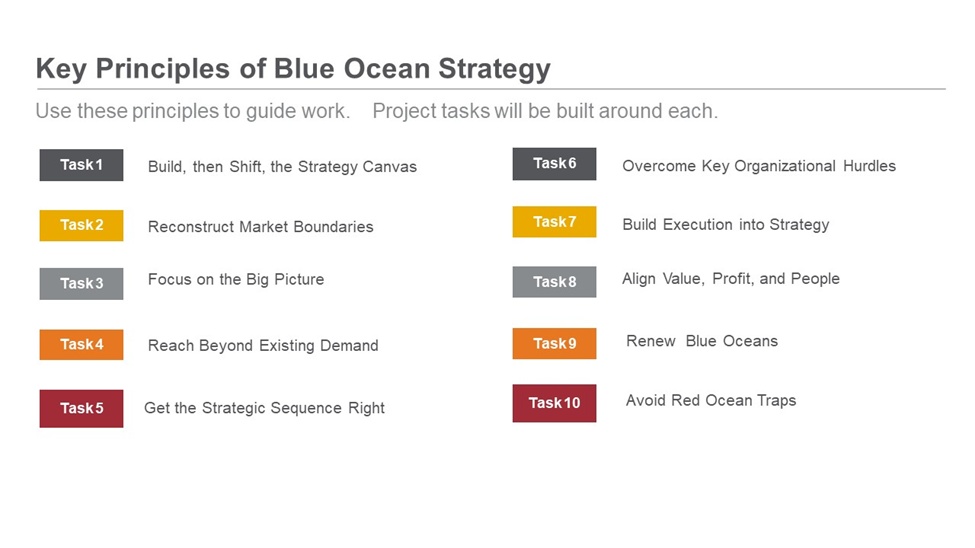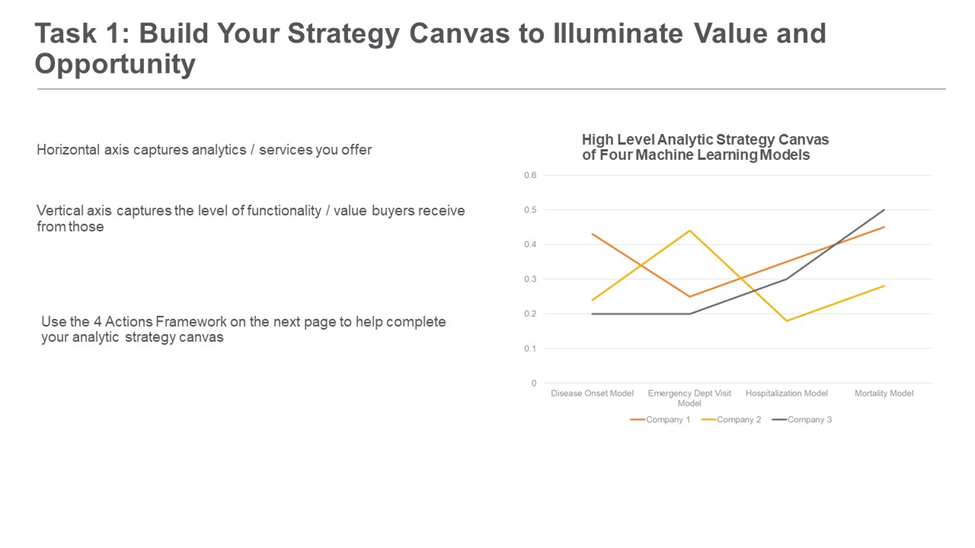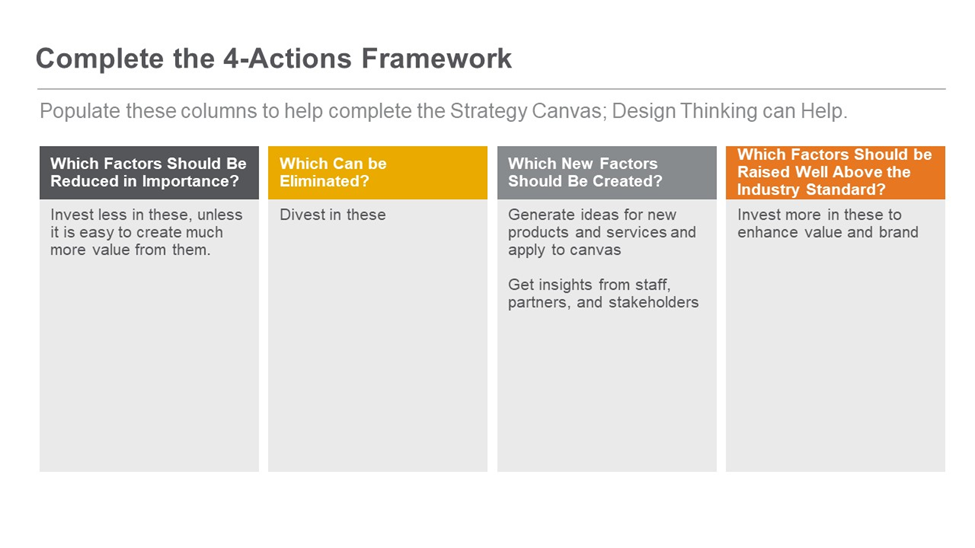https://ift.tt/dos1zTQ Combine analytics with Blue Ocean Strategy to generate new clients, increase profits, and create employee and custom...
Combine analytics with Blue Ocean Strategy to generate new clients, increase profits, and create employee and customer loyalty
Part I: Overview, Project Tasks, and the Strategy Canvas

(This paper was published previously in Open Data Science, on January 20, 2022, on https://opendatascience.com/using-data-science-to-develop-a-winning-business-strategy-part-1/.)
What role should data science teams have when creating a great business strategy that makes competitors irrelevant? The answer lies in an application of Blue Ocean Strategy, a set of concepts developed by W. Chan Kim and Reneé Mauborgne (2015) in their famous book by that name.
The Kim and Mauborgne (K&M) text is not related specifically to data science. In this three-part series I add a data science perspective to their concepts. I describe how data scientists can work with others across every organizational unit to develop a profitable business strategy, get more clients and enhance their satisfaction — without interference from existing competitors. Here in Part 1, I introduce the blue ocean process and describe its key concept, known as the strategy canvas, which drives every major task. Getting the strategy canvas right is a key factor in its success; getting it wrong can lead to lots of wasted time and money.
Blue ocean strategy is about creating new markets, so Part 2 will describe how data scientists can work others to do that.
Part 3 will focus on managing efficiencies in blue ocean strategy and on gaining support for it by aligning incentives in its favor. Since strategy is long-term by nature, Part 3 also describes how data scientists can help renew blue oceans and avoid traps that might subvert it. Finally, I’ll note its limitations and offer conclusions about how data scientists can contribute to blue ocean success.
The Blue Ocean
What exactly is the blue ocean? According to K&M, it is where potential clients work but your competitors do not (not yet, anyway). Quoting from their text (page 18), the blue ocean is where you can:
· Create uncontested market space
· Make the competition irrelevant
· Create and capture new demand
· Break the value-cost trade-off
· Align the whole system of a firm’s activities in pursuit of differentiation and low cost.
The blue ocean is business nirvana — there are no competitors to whittle away profits yet and it is easier to make a reputation for innovation in it. Getting there is not easy, but data science can help. This article describes how.
The blue ocean is best understood by contrasting it with the red ocean. Quoting again from page 18 of their text , K&M describe the red ocean as where firms:
· Compete in existing market space
· Beat the competition
· Exploit existing demand
· Make the value-cost tradeoff
· Align the whole system of a firm’s activities with its strategic choice of differentiation or low cost
The difference between these two oceans is clear. Red oceans are where most companies operate. They are competitive, hard to thrive in, and fairly well prescribed by the existing marketplace. Their focus is on beating other firms offering overlapping or otherwise similar products or services. Red markets can be profit-dwindling as more competitors arise or as existing competitors catch onto the newest technological or service wave. In contrast, blue oceans focus on making the competition irrelevant. They do this by being the first to solve the same or similar problems as your red ocean clients are facing, but they do it for different types of clients in perhaps different industries. This creates substantial new value and growth potential.
The Role of Data Science in the Blue Ocean
In a nutshell, the role of data science in blue ocean strategy is to provide insights needed by team members across the business, to help them find blue oceans and thrive there. Those insights arise from the following ten principles K&M describe, and in this series we describe how data scientists can contribute to each one.

Building the Strategy Canvas
According to K&M, the first task for the data scientist and others is to construct a strategy canvas, then shift it to focus on aspects of your modeling efforts that clients find more valuable. These aspects might therefore appeal to prospects (i.e., potential new clients) who have problems your firm can solve, but who are not in your current market space. Thus, the purpose of this task is to better understand the kinds of value that clients are most interested in purchasing. K&M describe the strategy canvas as “an analytic framework that is central to value innovation and the creation of blue oceans” (p. 27).
The following figure illustrates the concept with four machine learning (ML) prediction models. To illustrate the canvas, assume that, taken together, producing these models can help create an uncontested market space for a firm interested in maximizing the wellbeing of a population of interest. One model focuses on predicting the onset of a particular medical problem. The other three focus on predicting ramifications of that illness (i.e., visiting an emergency room for acute manifestations of the illness, hospitalization to treat serious developments, and mortality from the illness):

The vertical axis of the strategy canvas rates how much utility clients are expected to get from each analytic model, from zero to one. The horizontal axis labels the models to describe their focus. The three lines represent the strategy canvas for three different firms which may seek to enter a blue ocean. The one(s) that do enter can do so by performing the remaining nine tasks.
In healthcare applications, examples of risk models like these abound. For instance, they might include logistic regression or other linear or nonlinear classification models that epidemiologists generate to estimate probabilities of being diagnosed with COVID-19, being hospitalized with it, dying from it, surviving but subsequently developing long-term health problems from it, or fully recovering from it. Such models can be generated for many other acute or chronic conditions as well. Dozens of examples can be found in Healthcare Data Analytics by Chandan K Reddy and Charu C Aggarwal (2015). These models may be sold directly to clients who can gain access to them from cloud-based platforms. Models also may be aggregated as inputs, along with many other features, to create products or services used by many clients. Those other features could be shown on the strategy canvas as well.
Creating the canvas for the firms shown above involves estimating the utility their clients or potential clients would get from each model. Assume this knowledge might help each firm figure out how to create something of value for other companies who have similar problems to solve and who operate in another industry not currently served.
The strategy canvas also can be crafted to reflect more granular activities undertaken by data scientists, to rate the value created by many different types of machine learning or deep learning approaches. This might be the case if the firm is marketing its wares based upon the relative sophistication or performance of its modeling approaches. In-depth discussions of performance metrics can be found in any good machine learning textbook (e.g., Geron, 2019). Detailed discussions of other modeling attributes such as interpretability, transparency, fairness, or scalability can be found in Hall and Gill (2019).The thinking here might be that “our models are better so the insights you get from them are more useful,” or something like that. See my earlier article for information about 101 different modeling approaches data scientists might consider in their efforts to produce useful insights.
The general idea behind the strategy canvas is to assess the utility of each model or each model feature of interest to a potential marketplace. The differences between each line on the canvas denote how the three companies vary in terms of the value they perceive their clients to get from each model. Their relative levels of investment in each model may vary accordingly.
Since the lines for the three firms differ, which one (if any) is correct? Is there an optimal combination? We are interested primarily in blue oceans, not red ones, so we do not care much about each firm individually. We want to figure out how we can use information about the best things firms in our industry currently offer (i.e., about the state of the art) to help us create uncontested market space elsewhere.
To understand the state of the art, we need an arbiter of truth related to each model or feature denoted by the strategy canvas. That arbiter could perhaps be based on industry trends in sales over time across the firms. If sales across the industry are growing, and if one firm is clearly distancing itself from the others in sales, the features or models it is developing may be more useful to clients elsewhere too. Thus, growth in industry sales and intelligence about which firms are dominating a current industry might provide important clues about how to tweak your investments when crafting analytic models for a different, blue, ocean where those competitors are not operating.
Another arbiter might be illustrated in company comparisons generated by third parties, such as IDC, Chilmark, and Gartner. All three generate ratings of company offerings in many industries and have focused more than once on the quality of analytics-based offerings from many firms. While these ratings are typically used to differentiate firms in red oceans, the companies identified as having the best or leading-edge analytics might be more likely to apply their wares in blue oceans as well. They might have models or model features that are more likely to be successful in blue oceans. Thus, data scientists and strategists who want to understand customer value better may find some clues in the market insights generated by IDC, Chilmark, or Gartner. They might use these reports, along with the sales trends and intelligence mentioned earlier, to craft an optimal combination of models or features that might fare well in a blue ocean.
Shifting the Strategy Canvas
The notion of shifting your strategy canvas can be explained by considering the next figure. The 4-Actions Framework it illustrates was created by K&M. Answering the questions posed in each column of the figure, using market intelligence and information from clients and prospects, can help your firm decide which models or model features are more highly valued in several markets. Data scientists could then emphasize those in their efforts to help find blue oceans.

One more point about the figure above is worth mentioning. Its remark about Design Thinking is a reference to how data scientists, product managers, business development and marketing staff, and others can work together with clients and prospects. They would collaborate to get a better understanding of which problems are most worth solving; what would be gained in client utility, reputation, revenue, and profits by solving those problems; what barriers exist to solving those problems; what it would take and how much it would cost to surmount those barriers; and how to go about solving the problems.
Design Thinking sessions address each of these issues systematically, with input from each stakeholder. The role of the data scientist is to add perspective about each issue and influence thinking and discussion accordingly, just like every other stakeholder. Leaving data scientists out of these discussions (i.e., giving feedback to the data science team post hoc) is usually a mistake because most others will not be aware of the time, resources, or other issues data scientists consider to make models useful. Leaving out the analysts also deprives data scientists of first-hand knowledge of how stakeholders think; this can increase misunderstandings down the road that can lead to less useful offerings, production delays, or increased costs. Design thinking with data scientists and others can provide many useful clues about models or model features that would be successful in blue oceans.
Since the entire point of blue ocean strategy is to create new markets for the offerings that data scientists and others produce, Part 2 of this series will build upon the strategy canvas concept and describe how to reconstruct market boundaries and reach beyond existing demand to find a blue ocean. An example will be provided and the importance of visualization tools that data scientists use will be described. This will set the stage for the final article in this series, where we describe how to manage challenges to the blue ocean process and avoid mistakes that can lead us back into competitive red oceans. Stay tuned.
References
A. Géron, Hands-on Machine Learning with Scikit-Learn, Keras, and TensorFlow: Concepts, Tools, and Techniques to Build Intelligent Systems, 2nd Edition (2019), Sebastopol, CA: O’Reilly Media, Inc.
P. Hall and N. Gill, An Introduction to Machine Learning Interpretability: An Applied Perspective on Fairness, Accountability, Transparency, and Explainable AI (2021), Boston, MA: O’Reilly Media, Inc.
IDEO.org, Field Guide to Human-Centered Design (2015), on designkit.org
W.C. Kim and R. Mauborgne, Blue Ocean Strategy (2015), Boston, MA: Harvard Business Review Press
T. Murallie, Create Stunning Visualizations with Pandas Dataframes in one line of Code (2022), Towards Data Science, on https://towardsdatascience.com/advanced-pandas-plots-e2347a33d576
R. Ozminkowski, What do 101 Dalmations and Machine Learning have in Common? (2021), Toward Data Science, on https://towardsdatascience.com/what-do-101-dalmations-and-machine-learning-have-in-common-9e389b899df3
C.K. Reddy and C.C. Aggarwal, Healthcare Data Analytics (2015), Boca Raton FL: CRC Press, Taylor & Francis Group
Using Data Science to Develop a Winning Business Strategy, Part 1 was originally published in Towards Data Science on Medium, where people are continuing the conversation by highlighting and responding to this story.
from Towards Data Science - Medium https://ift.tt/Gdy6w8c
via RiYo Analytics

ليست هناك تعليقات